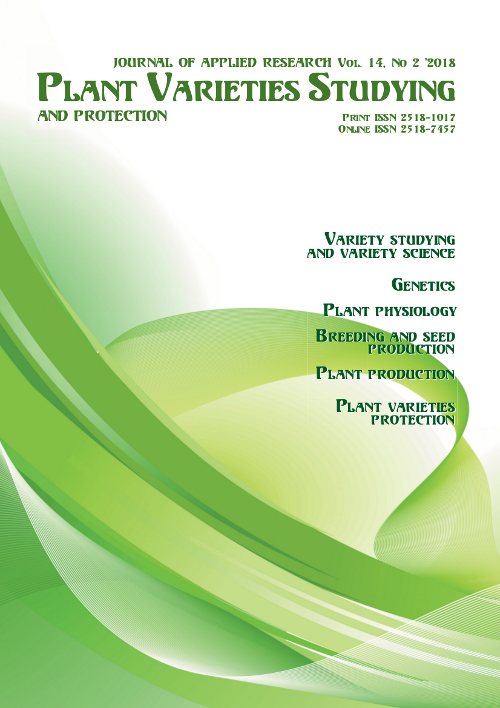Growth and productivity of some foreign cultivars of energy willow in Volyn Opillia
DOI:
https://doi.org/10.21498/2518-1017.14.2.2018.134775Keywords:
energy plantations, Salix L., varieties, biometric indexes, dry biomass yielsAbstract
Purpose. To examine the feasibility of using certain foreign cultivars of willow for energy plantations under the conditions of the Volyn Opillia.
Methods. Field, laboratory, analytical, and statistical. The objects of research was energy plantations of four Swedish willow cultivars (‘Tora’, ‘Tordis’, ‘Inger’, and ‘Wilhelm’), three Polish varieties (‘1047’, ‘82’, and ‘1057’) and one Hungarian variety (‘Express’). The plantations were established in 2012/13 yrs on the old-arable lands in Volyn Opillya.
Results. Biological characteristics of the cultivars under study and planting density significantly affect the survivability of cuttings, their bushiness, a number of sprouts per hectare, plant height, the average diameter of sprouts and energy biomass productivity. After the first year of cultivation, the highest yield of dry mass was obtained in variants with the highest planting density (22500 plants/ha). During the second growing season, a significant increase in biomass yield was observed in all variants. It was especially intensive at a planting density of 16400 plants/ha. After the third year of vegetation, the highest yield of ‘Tora’, ‘Inger’ and ‘Tordis’ cultivars was reached at the density of 16400 cuttings per hectare.
Conclusions. Under the conditions of Volyn Opillya, the highest dry biomass productivity over the three-year harvest cycle of growing Swedish cultivars was as following: ‘Tora’ 25.72–28.12 t/ha, ‘Inger’ 26.71–30.27 t/ha, and ‘Tordis’ 21.58 to 27.56 t/ha. The conducted hierarchical cluster analysis of the studied cultivars for the survivability of cuttings, a set of biometric indicators and productivity showed that they are combined into 2 clusters. The first cluster includes cultivars of Swedish selection – ‘Tora’ and ‘Inger’, which have the highest rates for all the characteristics of growth and productivity. The second variety includes the remaining varieties, which are, to varying degrees, promising for cultivation in Volyn Opillia. This is especially true for the ‘Tordis’, ‘Wilhelm’ and ‘Express’ varieties located on the right side of the second cluster and are characterized by high performance. Energy plantations of willow should be established with an initial density of 12000–15000 plants per 1 hectare under the conditions of the Volyn Opillia.
Downloads
References
Heletukha, H. H., & Martsenyuk, Z. A. (1998). Energy potential of biomass in Ukraine. Promyshlennaya teplotekhnika [Industrial Heat Engineering], 20(4), 52–55. [in Russian]
Chmeruk, T. (2018). Trends in alternative energy of Ukraine: from decay to progress. Dzerkalo Tyzhnia. Ukraina [Mirror Weekly. Ukraine]. Retrieved from https://dt.ua/energy_market/trendi-alternativnoyi-energetiki-ukrayini-vid-zanepadu-do-progresu-268117_.html
Sinchenko, V. M. (Ed.). (2015). Enerhetychna verba: tekhnolohiia vyroshchuvannia ta vykorystannia [Energy willow: technology of cultivation and use]. Vinnytsia: Nilan-LTD. [in Ukrainian]
Fuchylo, Ya. D., & Sbytna, M. V. (2009). Verby Ukrainy (biolohiia, ekolohiia, vykorystannia) [Willows of Ukraine: biology, ecology, use]. Kyiv: Logos. [in Ukrainian]
Tsarev, A. P., Pogiba, S. P., & Trenin, V. V. (2003). Selektsiya i reproduktsiya lesnykh drevestnykh porod [Breeding and reproduction of forest timber species]. Moscow: Logos. [in Russian]
El Bassam, N. (2010). Handbook of Bioenergy Crops. A Complete Reference to Species, Development and Applications. London; Washington, DC: Earthscan.
McCracken, A. R., & Dawson, W. M. (1998). Interaction of willow (Salix) clones growing in mixtures. Tests Agrochem. Cult., 19, 54–55.
Caslin, B., Finnan, J., & McCracken, A. (Eds.). (2012). Willow Varietal Identification Guide. Carlow, Ireland: Teagasc & AFBI.
The ‘Express®’ willow variety features. Retrieved from http://www.silvanusforestry.com/expressfuz-en.html
Sinchenko, V. M. (Ed.). (2018). Metodolohiia doslidzhennia enerhetychnykh plantatsii verb i topol [Methodology for studying of energy plantations of willow and poplar]. Kyiv: Komprynt. [in Ukrainian]
Downloads
Published
How to Cite
Issue
Section
License
Copyright (c) 2018 Я. Д. Фучило, І. В. Гнап

This work is licensed under a Creative Commons Attribution-ShareAlike 4.0 International License.
Our journal abides by the CREATIVE COMMONS copyright rights and permissions for open access journals.
Authors, who are published in this journal, agree to the following conditions:
1. The authors reserve the right to authorship of the work and pass the first publication right of this work to the journal under the terms of a Creative Commons Attribution License, which allows others to freely distribute the published research with the obligatory reference to the authors of the original work and the first publication of the work in this journal.
2. The authors have the right to conclude separate supplement agreements that relate to non-exclusive work distribution in the form in which it has been published by the journal (for example, to upload the work to the online storage of the journal or publish it as part of a monograph), provided that the reference to the first publication of the work in this journal is included.


























 Ukrainian Institute for Plant Varieties Examination
Ukrainian Institute for Plant Varieties Examination  Селекційно-генетичний інститут
Селекційно-генетичний інститут Institute of Plant Physiology and Genetics of the National Academy of Sciences of Ukraine
Institute of Plant Physiology and Genetics of the National Academy of Sciences of Ukraine
 The National Academy of Agrarian Sciences of Ukraine
The National Academy of Agrarian Sciences of Ukraine